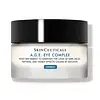What's inside
What's inside
 Key Ingredients
Key Ingredients

 Benefits
Benefits

 Concerns
Concerns

 Ingredients Side-by-side
Ingredients Side-by-side

Water
Skin ConditioningGlycerin
HumectantButylene Glycol
HumectantImperata Cylindrica Root Extract
Skin ConditioningDimethyl Isosorbide
SolventMeadowfoam Delta-Lactone
Skin ConditioningRetinyl Propionate
Skin ConditioningRetinol
Skin ConditioningSwertia Chirata Leaf Extract
AstringentUrea
BufferingYeast Amino Acids
HumectantTrehalose
HumectantInositol
HumectantTaurine
BufferingBetaine
HumectantFucus Vesiculosus Extract
EmollientGlycine Soja Extract
Skin ConditioningMacrocystis Pyrifera Extract
Skin ConditioningIsopropyl Palmitate
EmollientLecithin
EmollientPvp
Emulsion StabilisingHexylene Glycol
EmulsifyingCaprylyl Glycol
EmollientPunica Granatum Seed Oil
EmollientCaprylic/Capric Triglyceride
MaskingPvm/Ma Decadiene Crosspolymer
PEG-8
HumectantCarbomer
Emulsion StabilisingSodium Bisulfite
AntioxidantSilica
AbrasiveSodium Hydroxide
BufferingChlorphenesin
AntimicrobialPhenoxyethanol
PreservativeParfum
MaskingCI 77891
Cosmetic ColorantSynthetic Fluorphlogopite
CI 14700
Cosmetic ColorantCI 19140
Cosmetic ColorantWater, Glycerin, Butylene Glycol, Imperata Cylindrica Root Extract, Dimethyl Isosorbide, Meadowfoam Delta-Lactone, Retinyl Propionate, Retinol, Swertia Chirata Leaf Extract, Urea, Yeast Amino Acids, Trehalose, Inositol, Taurine, Betaine, Fucus Vesiculosus Extract, Glycine Soja Extract, Macrocystis Pyrifera Extract, Isopropyl Palmitate, Lecithin, Pvp, Hexylene Glycol, Caprylyl Glycol, Punica Granatum Seed Oil, Caprylic/Capric Triglyceride, Pvm/Ma Decadiene Crosspolymer, PEG-8, Carbomer, Sodium Bisulfite, Silica, Sodium Hydroxide, Chlorphenesin, Phenoxyethanol, Parfum, CI 77891, Synthetic Fluorphlogopite, CI 14700, CI 19140
Water
Skin ConditioningGlycerin
HumectantDimethicone
EmollientIsohexadecane
EmollientParaffin
PerfumingPropylene Glycol
HumectantSilica
AbrasivePolyglyceryl-4 Isostearate
EmulsifyingCetyl PEG/PPG-10/1 Dimethicone
EmulsifyingHexyl Laurate
EmollientNylon-12
Hydroxypropyl Tetrahydropyrantriol
Skin ConditioningMethylsilanol/Silicate Crosspolymer
Skin ConditioningPolyethylene
AbrasiveAscorbyl Glucoside
AntioxidantCaprylic/Capric Triglyceride
MaskingOctyldodecanol
EmollientPhenoxyethanol
PreservativeTocopheryl Acetate
AntioxidantAmmonium Polyacryloyldimethyl Taurate
Emulsion StabilisingPEG-6 Isostearate
EmulsifyingTriethanolamine
BufferingSodium Citrate
BufferingMethylparaben
PreservativeChlorphenesin
AntimicrobialCaffeine
Skin ConditioningTitanium Dioxide
Cosmetic ColorantEthylparaben
PreservativeMenthoxypropanediol
MaskingVaccinium Myrtillus Fruit Extract
Skin ConditioningHesperidin Methyl Chalcone
AntioxidantPentasodium Pentetate
Aluminum Hydroxide
EmollientStearic Acid
CleansingHesperetin Laurate
AntioxidantN-Hydroxysuccinimide
Skin ConditioningDipeptide-2
Skin ConditioningPalmitoyl Tetrapeptide-7
Skin ConditioningPalmitoyl Oligopeptide
CleansingChrysin
Skin ConditioningWater, Glycerin, Dimethicone, Isohexadecane, Paraffin, Propylene Glycol, Silica, Polyglyceryl-4 Isostearate, Cetyl PEG/PPG-10/1 Dimethicone, Hexyl Laurate, Nylon-12, Hydroxypropyl Tetrahydropyrantriol, Methylsilanol/Silicate Crosspolymer, Polyethylene, Ascorbyl Glucoside, Caprylic/Capric Triglyceride, Octyldodecanol, Phenoxyethanol, Tocopheryl Acetate, Ammonium Polyacryloyldimethyl Taurate, PEG-6 Isostearate, Triethanolamine, Sodium Citrate, Methylparaben, Chlorphenesin, Caffeine, Titanium Dioxide, Ethylparaben, Menthoxypropanediol, Vaccinium Myrtillus Fruit Extract, Hesperidin Methyl Chalcone, Pentasodium Pentetate, Aluminum Hydroxide, Stearic Acid, Hesperetin Laurate, N-Hydroxysuccinimide, Dipeptide-2, Palmitoyl Tetrapeptide-7, Palmitoyl Oligopeptide, Chrysin
 Reviews
Reviews

Alternatives
Ingredients Explained
These ingredients are found in both products.
Ingredients higher up in an ingredient list are typically present in a larger amount.
This ingredient is an emollient, solvent, and texture enhancer. It is considered a skin-softener by helping the skin prevent moisture loss.
It helps thicken a product's formula and makes it easier to spread by dissolving clumping compounds.
Caprylic Triglyceride is made by combining glycerin with coconut oil, forming a clear liquid.
While there is an assumption Caprylic Triglyceride can clog pores due to it being derived from coconut oil, there is no research supporting this.
Learn more about Caprylic/Capric TriglycerideChlorphenesin is a synthetic preservative. It helps protect a product against bacteria in order to extend shelf life. In most cases, Chlorphenesin is paired with other preservatives such as phenoxyethanol and caprylyl glycol.
Chlorphenesin is a biocide. This means it is able to help fight the microorganisms on our skin. It is also able to fight odor-releasing bacteria.
Chlorphenesin is soluble in both water and glycerin.
Studies show Chlorphenesin is easily absorbed by our skin. You should speak with a skincare professional if you have concerns about using Chlorphenesin.
Learn more about ChlorphenesinGlycerin is already naturally found in your skin. It helps moisturize and protect your skin.
A study from 2016 found glycerin to be more effective as a humectant than AHAs and hyaluronic acid.
As a humectant, it helps the skin stay hydrated by pulling moisture to your skin. The low molecular weight of glycerin allows it to pull moisture into the deeper layers of your skin.
Hydrated skin improves your skin barrier; Your skin barrier helps protect against irritants and bacteria.
Glycerin has also been found to have antimicrobial and antiviral properties. Due to these properties, glycerin is often used in wound and burn treatments.
In cosmetics, glycerin is usually derived from plants such as soybean or palm. However, it can also be sourced from animals, such as tallow or animal fat.
This ingredient is organic, colorless, odorless, and non-toxic.
Glycerin is the name for this ingredient in American English. British English uses Glycerol/Glycerine.
Learn more about GlycerinPhenoxyethanol is a preservative that has germicide, antimicrobial, and aromatic properties. Studies show that phenoxyethanol can prevent microbial growth. By itself, it has a scent that is similar to that of a rose.
It's often used in formulations along with Caprylyl Glycol to preserve the shelf life of products.
Silica, also known as silicon dioxide, is a naturally occurring mineral. It is used as a fine, spherical, and porous powder in cosmetics.
Though it has exfoliant properties, the function of silica varies depending on the product.
The unique structure of silica enhances the spreadability and adds smoothness, making it a great texture enhancer.
It is also used as an active carrier, emulsifier, and mattifier due to its ability to absorb excess oil.
In some products, tiny microneedles called spicules are made from silica or hydrolyzed sponge. When you rub them in, they lightly polish away dead skin layers and enhance the penetration of active ingredients.
Learn more about SilicaWater. It's the most common cosmetic ingredient of all. You'll usually see it at the top of ingredient lists, meaning that it makes up the largest part of the product.
So why is it so popular? Water most often acts as a solvent - this means that it helps dissolve other ingredients into the formulation.
You'll also recognize water as that liquid we all need to stay alive. If you see this, drink a glass of water. Stay hydrated!
Learn more about Water